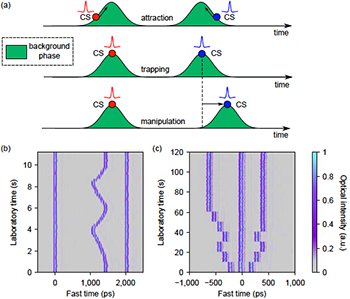 (a) Temporal CSs (red and blue) circling the cavity drift (top) toward the nearest phase maxima (green), which then act as trapping sites (middle). Once trapped, the CSs follow the changes in phase pattern (bottom). (b and c) Evolution of the intracavity temporal intensity profile with CSs moving continuously (b) and in discrete steps (c).
(a) Temporal CSs (red and blue) circling the cavity drift (top) toward the nearest phase maxima (green), which then act as trapping sites (middle). Once trapped, the CSs follow the changes in phase pattern (bottom). (b and c) Evolution of the intracavity temporal intensity profile with CSs moving continuously (b) and in discrete steps (c).
Conventional optical tweezers manipulate physical objects in space using laser light.1 This year, we showed similar manipulation of light itself, in time—the temporal tweezing of light.2 We have selectively moved around ultrashort light pulses in time, with respect to and independently of each other, achieving exquisite control over light.
The pulses we manipulate are temporal cavity solitons (CSs): packets of light persisting in a passive nonlinear cavity (in the case of our work, an optical-fiber loop).3 Multiple temporal CSs can be present independently at arbitrary temporal positions around the cavity, encoding binary data. As solitons, these pulses do not disperse over time. Their power losses are also balanced by an external continuous-wave laser beam coherently driving the cavity. This ensures propagation and storage of CSs for an unlimited time.
Additionally, the temporal CSs are phase-locked to the driving beam. Consequently, simple phase modulation of the driving beam creates trapping sites for the CSs, which are attracted to the phase maxima.4 By dynamically changing the phase pattern, we controllably move the CSs in time, in essence selectively speeding them up or slowing them down.
Among the manipulations demonstrated (see figure), we have trapped three CSs into three phase pulses, continuously varying the relative position of the second trapping pulse with respect to the others. Correspondingly, temporal CSs at 2-ns intervals are observed to be fixed, while the middle one follows the change in phase pattern, continuously moving back and forth over a range of 360 ps. This delay corresponds to 140 soliton widths, much longer than what could be obtained with slow-light techniques,5 and is limited only by our electronic delay line.
In a second manipulation, the phase pulses are shifted in discrete 100-ps steps, and several phase pulses are changed at once in various combinations. The CSs follow these abrupt changes, demonstrating independent and simultaneous temporal tweezing of several-ps-duration optical pulses. This technique immediately enables all-optical reconfiguration of a binary data stream, with potential benefits for optical information processing.
Researchers
Jae K. Jang, Miro Erkintalo, Stéphane Coen and Stuart G. Murdoch, University of Auckland, Auckland, New Zealand
References
1. A. Ashkin et al. Opt. Lett. 11, 288 (1986).
2. J.K. Jang et al. Nat. Commun. 6, 7370 (2015).
3. F. Leo et al. Nat. Photon. 4, 471 (2010).
4. W.J. Firth and A.J. Scroggie. Phys. Rev. Lett. 76, 1623 (1996).
5. R.W. Boyd et al. Opt. Photon. News 17(4), 18 (2006).
